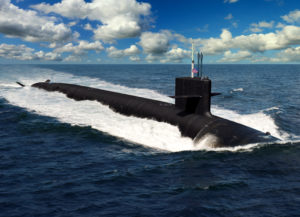A Navy official this week confirmed the service plans to buy five Columbia-class nuclear-armed ballistic missile submarines (SSBNs) in a block buy after the first two vessels, while also noting there is not much margin left in the schedule for the first vessel.
“For long range planning and to signal the industrial base…our plan will be to buy the next five ships in a block, trying to buy as much as that material, long-lead type material, pull that to the left,” Rear Adm. Scott Pappano, Program Executive Officer for Strategic Submarines, said on Nov. 1 during the annual Naval Submarine League symposium.
The first new submarine of the class, the future USS District of Columbia (SSBN-826), held a keel laying ceremony in June and is expected to deliver in fiscal year 2028 (Defense Daily, June 6).

The Navy is procuring 12 Columbia-class SSBNs to replace the 14 aging Ohio-class SSBNs, which are expected to start retiring in 2027. SSBN-826 is planned to be delivered by FY ‘28 and be on its first patrol by FY ‘30 to relieve the first Ohio-retirements. The first new submarine is under full rate production while the second vessel, SSBN-827, is under advanced construction.
Pappano said the five-boat block buy aims to help level up the industrial base and “give that positive demand signal,” for industry.
He also told reporters SSBN-826 is down to only about one month of margin compared to a planned six months.
“To be frank, right now, we’re about five months off [the planned margin], we have about one month of margin…on the good to the contract. But I’m five months [off] on what I really, really wanted to be up front.”
Pappano reiterated the official Columbia-class contract plan allows for an 84-month construction time, or seven years per submarine, along with an internal schedule of 78 months to maintain at least six months of margin. 84 months is the same time allotted for the Virginia-class attack submarines, “even though it’s two and a half times bigger. So we knew that’s pretty aggressive to give ourselves a chance at that,” he said.
The Navy’s internal 78 month schedule is with prime shipbuilder General Dynamics’ Electric Boat [GD], “so pull that six months to the left – the goal was to have them doing shipbuilding activities to deliver at 78 months, so that I had that margin at the end,” Pappano continued.

HII [HII] is also building major parts of the Columbia-class submarines as the main subcontractor to GD.
SSN-827 construction has held at one to two months of margin for at least the last year. During the 2021 symposium, Pappano said there was about two months of margin left, in part due to welding mistakes by BWX Technologies [BWXT] to a dozen common missile tubes (Defense Daily, Nov. 18, 2021).
However, Pappano said in recent months there have been some SSBN-827 construction improvements after Electric Boat and HII got past “some early startup issues” using new digital processes to push work instructions to end user builders at the shipbuilding facilities.
Now the companies are getting past those issues and “over the last two months, we’ve seen the two best months since we started construction, essentially. So some aggressive work that we did over the summer, because we were kind of plateauing a little bit, we needed to drive higher. Great work by the companies to go drive both the work construction development and the end use construction hours up to the best we’ve seen over the last few months.”
Pappano noted it is important to regaining any margin to help help him “deal with any unknown unknowns out there in the future. So that’s our mission right now is to pull that to the left.”